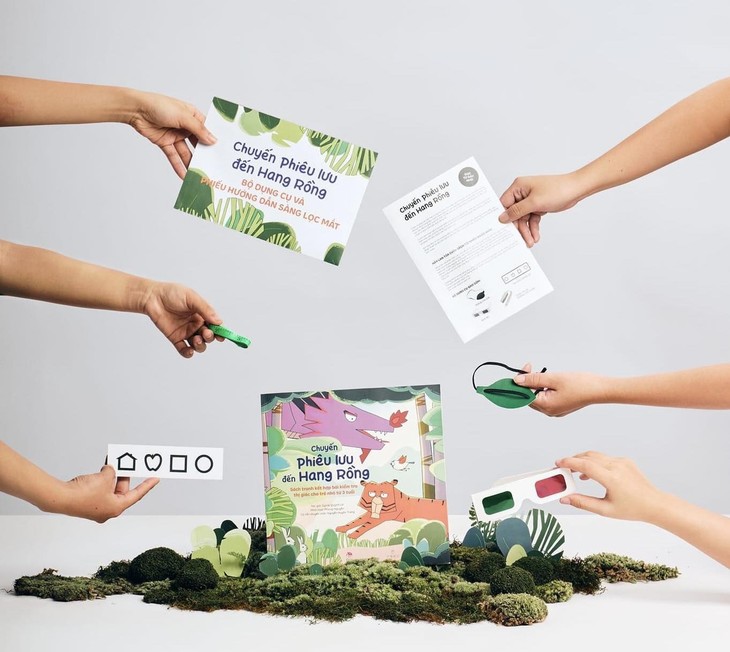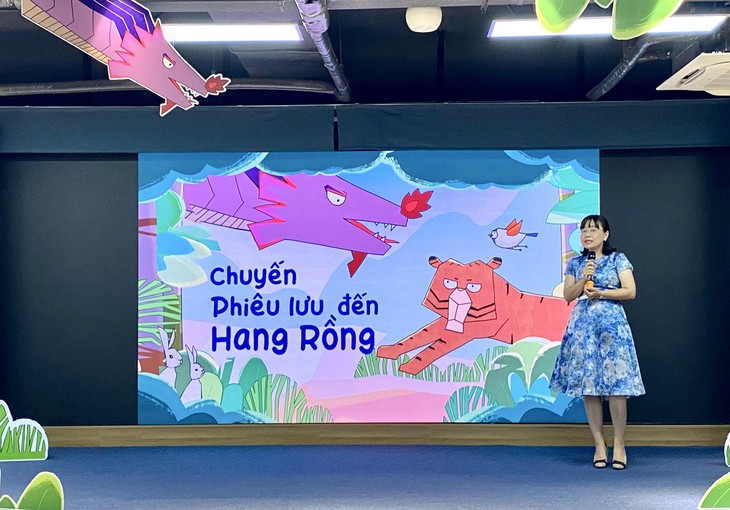(VOVWORLD) - Early eye check-ups can help detect eye problems at an early stage to protect eyesight and prevent vision loss. But for various reasons, people tend to visit a doctor only when they have a pressing issue. A picture book of medical-standard vision tests for children from age 3 and up that parents can use at home with the advice of a doctor to protect their children’s eyesight has been released recently.
 “Adventure to the Dragon’s Den” comes with a test kit and instructions for parents or teachers to perform the test on children. “Adventure to the Dragon’s Den” comes with a test kit and instructions for parents or teachers to perform the test on children. |
“Chuyen Phieu Luu Den Hang Rong” (Adventure to the Dragon’s Den) is the first vision test picture book in Vietnam for children from 3 years old. It comes with a test kit and instructions for parents or teachers to perform the test on children.
The online instructions guide users to prepare a home setting for testing, shows them how to use the test kit with images in the book, and details very specific steps.
Optometrist Nguyen Huyen Trang of Hanoi Medical University Hospital said “Adventure to Dragon’s Den" is a tool to help parents perform early eye vision tests on their children.
"Many children come to us when they already have eye problems, usually lazy eye or poor vision. This book incorporates vision tests for three basic eye problems that parents can perform at home. They are an eyesight test, a color vision test which differentiates colors, and a 3D vision test which is also known as depth perception to help us direct our steps and movement”.
Doctor Trang said the book tells a story about an adventure of a dragon, a tiger, and a sparrow, three popular animals with Vietnamese children. It aims to catch the attention of small children, who often don’t cooperate with doctors at medical centers.
The book is part of the broader charity program “Nha Cua Dom Dóm” (“House of Fireflies”) with the message “For a million bright eyes” in response to World Sight Day 2023.
Doctor Pham Thi Minh Chau, deputy head of the Department of Pediatric Ophthalmology of the Central Eye Hospital, pointed out that even small unusual eye behaviors can cause eye problems. It often takes parents and children some hours to get a comprehensive eye exam. Some small children are afraid of going to a medical center. So "Adventure to the Dragon’s Den" came into being, said Chau.
The book was studied by ophthalmic refraction experts to make an early vision test simpler and more relaxed for children and parents. Every day, parents and teachers should pay attention to their children’s eye behaviors, she said.
 Doctor Pham Thi Minh Chau, deputy head of the Department of Pediatric Ophthalmology of the Central Eye Hospital, speaks at the launch of the book. Doctor Pham Thi Minh Chau, deputy head of the Department of Pediatric Ophthalmology of the Central Eye Hospital, speaks at the launch of the book. |
“If the child has unusual, innate eye problems, but he is too young to know that his world is blurry it is because the world around him has been blurry since he was born. Parents should pay attention to whether the child often blinks his eyes or tilts his head to see things. Does he often stand close to the TV or bring things very close to his eyes? These are small symptoms that children may not know enough about to tell their parents,” said Dr. Chau.
“If we can have early detection of eye problems such as nearsightedness or astigmatism, we can slow down the progress of the disease. There are some eye diseases which can be reversed with treatment at an early stage, but even a little delay can lead to some vision loss. For example a white dot on the eye might indicate eye cancer.”
Children’s vision develops between zero and six years old. A child’s vision gets stronger each year. If eye disease is detected before six years old, medical treatment can help retain his eyesight. If treatment comes later, doctors have to solve the problem anatomically and will not be able to restore the child’s full visual function. In the digital era children grow up with many digital devices around them. These devices are one reason in which poor eyesight is caused at an early age, even before the children go to school.
“We should spend time to take our children out to play in nature and to stay away from digital devices. Nature’s large, 3D space and natural light are good for our vision. Natural light can maintain one’s good vision and also support eye treatment," said Dr. Chau.
"Parents should increase nutrient-rich foods such as vegetables and fruits with green, red, purple, and yellow colors. They are naturally absorbed and are beneficial when combined with outdoor activities such as playing sports.”
Dr. Chau and her research team hope that increasing communication will help parents and teachers become aware of the importance of early eye tests for their children which can be done at home or at schools before seeing doctors.